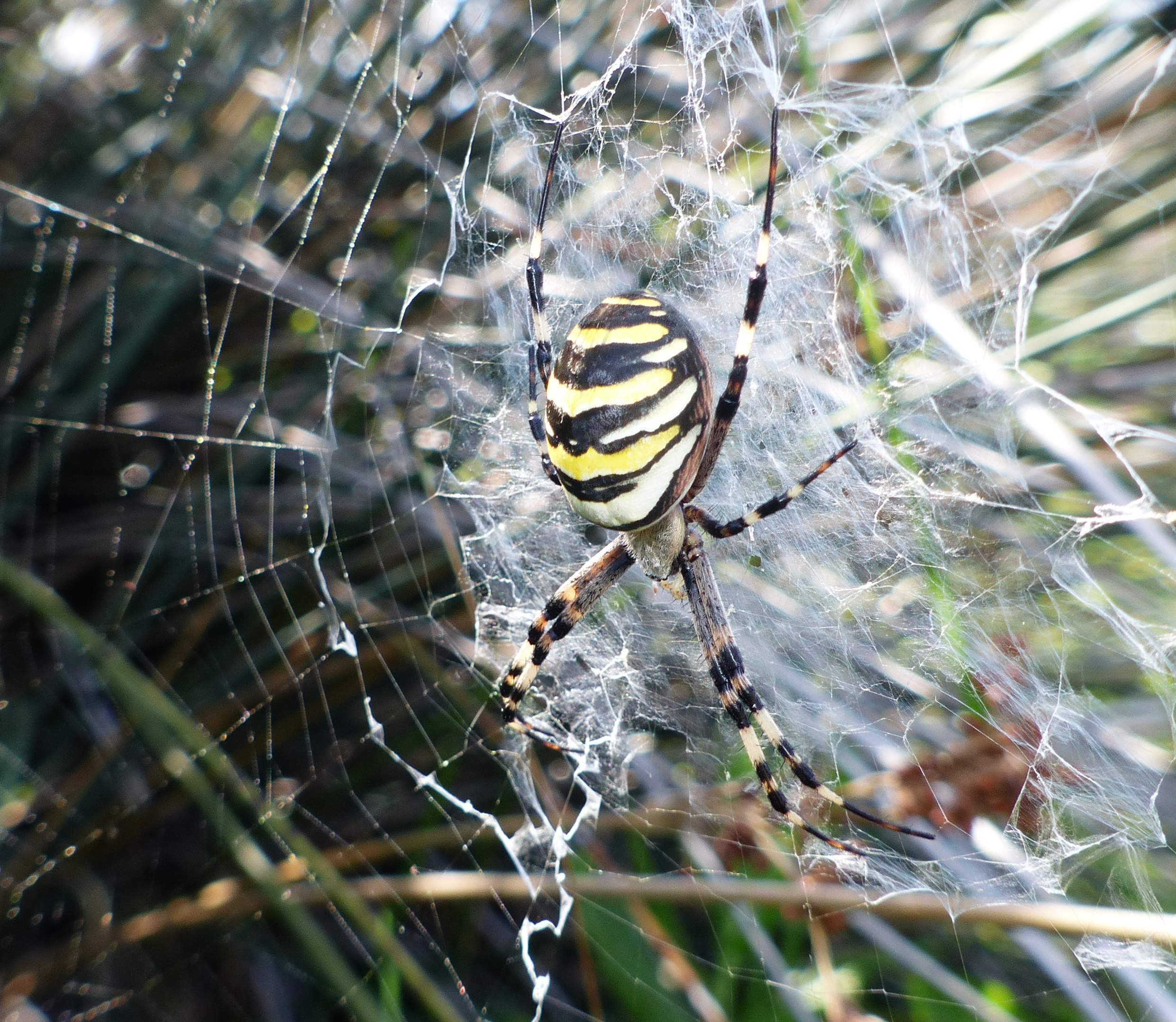Spiders are famous aesthetes. Many craft radially symmetric webs, first extruding long silken spokes and then spinning spiraling strands to snag prey. In the mornings, the intricately laid silk sparkles with dew drops. Your average, generic spiderweb spun by the most run-of-the-mill, Joe-Eightpack spider will still probably be one of the more beautiful structures constructed by invertebrates in your neighborhood—no offense to termites, which take a more brutalist approach to their design.
But some spiders take web design a step further. After spinning spokes and spirals, certain arachnids might add a cross made of zig-zagging lines, or a latticed nebula that radiates out from the center of the web. These embellishments, called stabilimenta, are spun with the toughest type of spider silk, known as aciniform silk, the kind they use to cocoon and immobilize prey. And though their beauty is clear, their purpose is hazy.

To a non-spider, stabilimenta make little sense. The strands are stark and white, making the webs more visible to predators that can detect ultraviolet light.
As such, scientists have long speculated about why, exactly, a spider might go and do something like this. Surely there must be some benefit that outweighs the downside of visibility, and warrants the tremendous physical effort of going so ham on decorations. "No one has fully understood its function," said Gabriele Greco, a researcher at the Swedish University of Agricultural Sciences in Uppsala, who self-describes as a physicist who is in love with spiders. As such, there are many hypotheses floating around—some, all, or none of which might explain the silken designs.
Some of the explanations scientists have proposed include but are not limited to: attracting prey by being conspicuous or scattering light; keeping the spider cool by way of shade; warning other animals like flying birds against destroying the web; intimidating predators by making the spider seem larger than it is; camouflaging a spider's eggs; or even collecting water droplets. What stabilimenta do not do, despite their name, is stabilize the web (although this is what scientists originally suspected.)

Greco learned of stabilimenta long ago. "Whenever you come across spider webs, it is almost impossible not to encounter one," he wrote in an email. He was fascinated by the beauty of the structures and their incomprehensibility to us. "This mystery is what intrigues me most: such an evident, beautiful structure without a clearly defined role," Greco said.
Today, Greco and colleagues published a new paper in the journal PLOS One suggesting a new theory behind stabilimenta. After investigated the mechanical properties of the decorations, they found that the stabilimenta have some effect on the vibrational properties of the web, which might help spiders better locate prey caught in their webs.

As a physicist, Greco was curious to understand the mechanics of stabilimenta, which no one had studied before. "When something strikes a spider web, vibrations propagate throughout the structure," he said. "So how could such a massive and conspicuous element as the stabilimentum not influence the way these vibrations travel?"
Luigi Lenzini, an independent researcher and an author on the new paper, had taken many photos of orb weaver spiders in the genus Argiope, which are known for their resplendent abdomens and elaborate stabilimenta. The researchers used Lenzini's trove of stabilimenta photos to create computer models of the webs, both with and without the embellishments.
When the scientists simulated the vibrational waves sent out from entangled prey, they found mixed results. If prey such as a fly collided with the web head-on, it would send vibrations perpendicular to the web. In the researchers' simulations, stabilimenta did not affect how these perpendicular vibrations traveled across the web. But once a fly begins to struggle in the silk, it sends out tangential vibrations in the same direction as the web. The researchers' simulations found the stabilimenta sent these tangential vibrations to a greater number of threads across the web. In other words, the stabilimenta might increase the spider's ability to pinpoint the location of the prey and help the arachnid hunt.

When I asked if Greco found the results surprising, he told me "absolutely," then clarified, "surprisingly negative, I would say." He'd predicted the stabilimenta would have a clearer effect on how the web vibrated. But he added that he was glad that PLOS One accepted the new paper, even though its findings lead to further questions. Greco and his colleagues had confirmed that stabilimenta do influence how vibrations travel across orb webs, even if how, exactly, was not so straightforward. "Results like these—where the outcome is not as clear or as striking as expected—are often difficult to publish," he said. "This experience has actually renewed my faith in scientific publishing."
These results are, for the moment, strictly theoretical, reserved to the world of simulation and not yet tested in the real world. "That’s why we hope to continue this work in collaboration with a biologist specialized in such structures," Greco said. For now, however, Greco has added yet another theory to the tangled web of our understanding of stabilimenta, which, until we can communicate with spiders themselves, only stokes the mystery of what these structures actually do. When asked for comment, the Argiope spiders provided the following statement:
y̷̢̧̛͇̭͙͎̖͈̹̤̺̖͔͇͐̈́̈̏͋̒̈́̐͒̍̈͘̚̚͘ͅo̷͉̱͔͚̟̜̬̩̿͗̑̓͗̄̾̓͌̕̚͘͠͠͝ű̶̳̭̪̣̙͇͎̹̣͖̞̱̬̻͇̃̋͆́ ̸̖̻͉̟̩̗̜̳̼͙͖͗͆̀w̵̧̢̤̥̙͙̝̦̞͒͐͐̆͊́̿͛͆̄̈́̅͠i̷̡̪̫͇̣̇͋͑̂͂́̏̑͂̐͠ͅl̶̦̂̓̊̔̇́̇̅̒͒̆̔̓ĺ̸̞̫̩̜̦̰̥̩͍̠͜ ̷̧̯̙̰̖̭̣͍͆̋̅́̍͛͂̐̂̆̐͆̕̕ǹ̶͇̦̳̙̒͜ë̴̛̲̍̀̓̌̈́̀̉͋̿́̚v̸̪͈̠̗̱̞̱̗̳͙̳̆̓̈́͌͛̈̔̇̍̒͝e̸̛̝̳͍̱̻̯̮̱̘̭̿̈́̍̾̃̿̊̌̓̚̕͜r̴̼̻̟̙̩̝̳̗͔̝̫͍͓͕̱̐͂́̌͑͠ͅ ̴̜̻̍̒̈͝u̷̅͂̓̐͝ͅn̸̛̛͇̘̪͛̓̒̉̇̃̾̚͠d̴͇͓̄́͛̾͐̂́̎̈͘͜͝e̵̢̛̻̞͉͈̲̳̟͔̙̤̪͇͋͊̈̔̇̅̀̏͊̚͝͝͝ͅͅͅr̴̜̙͓͚̬͇͔̯͍̟̙̪̓ș̷͇̫̲̼͕̼͒ͅţ̴͔̩̘̫̓̈́̆̈́͑͆̆̏̀͘͝͝a̷͈̬̞͊ṅ̶̨̡̡̦̔̑̋́͐͂̿͂̓̈́̈́͌̏͘ḓ̴̛̛̫͛̍̓̀̾͂͗̀͘ ̷̢͉̭̠̞̘̮̭̞̼̺̮̲̑͌̈́̐̃͋̿̂͒͝u̷̡̳̩̩̬͛̔̇̚s̷̢̲̮̮̠̺̼̣͒̒͌̑̈͆̽̅̒̆ ̷̦̺̹̞̳̮̩͚̲̱͇͖͚̟̋͗͑̕̕͜a̶̢̛̺͍̟̹̭̞͎̔̾̄̌̈̑̃̓̈̆̕ͅṋ̵̬̰̰͍̬̰̳͖̈́̀̽͂̅ḍ̷̪̦̳̭̜̻͔̏̇̓̆̑̒͑̇̈́́ ̴̧̘̖̫̺̬̲͙͚̻͚̈̇̄̚ͅơ̶̢̞̪̊̊̿̎͆̍̃ǔ̶̢̮̝̞̮̫̰̤̠͚̖͍͇̎͛̀͐͗̊̾̊̍̀̈́͂̀͝ŗ̵̧̛͙͈̪̥̻͋͛́͌͛͊͛ ̵̛̠̖͕̟͈͖̮͕̖͓͗̑̍̏̑̎͊̊́̄̉̌̃̕̕m̵̧̨̨̛̬̩̮̖̣̱̩̻̩͓͎̜̝͐̀̐͊̚ỷ̴̧̢̯̣͓̣̲̻̿͐͗̊̓̔͑̌̇͂̄́s̵̡̧̛͚̦̹̞̯͚̙̩̫̈͒̓̈́̇͐t̸̨͚͖͍̬̞͔͖̳̘͖́͆̋̉͂͒͘ͅȩ̷̛̛̭̺͈̍̈̃̂̔͌͐̈̏̎͝r̶̢̠̞͈̖͓̳͎̦̠͕̼̃̈́̈́̉̎̈́̌̕͝į̴̱̟͖̭̪͕͙̲̦̼̳̀̀̒̏͋͒ô̵̥̠̲̫͎̈̇͆̋̊̅͂̀̃̐̕û̷̜̞̟̤̤̹͖̥̝͎̟̇̄̇̀̉s̵̢̡͓͑ ̴̠͚̻̦̑̽͗̐̏͐͆̇̔̚͝w̸̧̨͖͓̠͕͍͓̣̭̙͛͊̾̅͝͠ą̶͚̤̘̙͔̘̎̊̄̍̽̃̏̿̒̍̀̒̏͠͝y̸̨͔̤͖̟̻̖̳̽̃͛̌̍̕s̵̢͉̖̘̭̘̓̄̐̃̕,̷̪̩͈͉͙͓͎͕͍̋̕ ̴̧͍̣͔̳̹̗̥͌̂̈́̋̄̋̄͑͊̔̇̎̆̉͜ṗ̸̧̭͙̫̬̳̫̜̻̠̯̭͗͛̉͌̿̂̂͂͜ͅi̵̩̾̇̊͑̓̉̽͘͠t̷͓̫͈̼̳̎̾̍̋̑͋̀͌̉̿̆̓̚̚̕͝i̸̪͖͇̫͖͑̀͑́̈́͂̈́̃̂̍̓͘f̸̢͉̳̯̗̹͇͕͙͖̲͊̈́ȕ̸̧̗̔̃̕l̵̡̨̝̙̝̣̫͎̼͇̠̼̋́̅͌̈́͐́ ̷̞́̿̄̾̀́̔̿͠͠ḥ̶̨̜̮̟͙̠̮̭͐̍̏̆́́͗̓̔̊̓̅̿ų̵̨̭͙͎̞̬̼̊̾̕̕͜͠m̴̢͕̜̤̹͓̟̤͍͊̒͗̍̈́̀̅̑̃̀̌͌͝à̶̧̨̛̯̤͖̹͆̅͋̂̓̑́͌̚͠ń̵͙͔̜̗̳̆̅̎̊́̓͛͒̀̑̏̾͝s̸̢̙̱̯͚̥̯̮͔͈̻͙͌͑̆̄̅͛͒́͊͘






